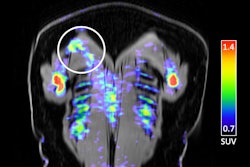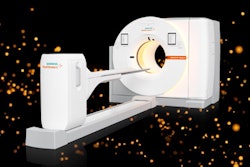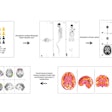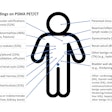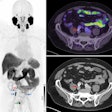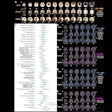A new molecular imaging agent targeting glypican-3 (GPC3) has shown high sensitivity and specificity in detecting hepatocellular carcinoma (HCC), according to research presented at the Society of Nuclear Medicine and Molecular Imaging (SNMMI) annual meeting.
In a pilot study, Mengting Li, PhD, of Wuhan Union Hospital in China and colleagues found that the agent, gallium-68 (Ga-68)-aGPC3-scFv, was well-tolerated and effective at providing high-contrast images of GPC3-positive liver tumors -- a result that suggests it could be a promising new tool for early diagnosis and staging of HCC, which is one of the most lethal forms of liver cancer.
"While current imaging and diagnosis of HCC primarily depend on contrast-enhanced CT or MRI to identify structural changes, PET imaging has the potential to reveal early molecular alterations that precede visible anatomical shifts," Li said in a statement released by the SNMMI.
 Patient 1: Ga-68-XH06 PET/MR images demonstrate intense radiotracer accumulation in histologically confirmed GPC3-positive hepatocellular carcinoma lesions (arrows). Patient 2: Ga-68-XH06 PET/MR images clearly delineate sub-centimeter GPC3-positive hepatocellular carcinoma lesions (arrows) with intense focal uptake.Images courtesy of the SNMMI
Patient 1: Ga-68-XH06 PET/MR images demonstrate intense radiotracer accumulation in histologically confirmed GPC3-positive hepatocellular carcinoma lesions (arrows). Patient 2: Ga-68-XH06 PET/MR images clearly delineate sub-centimeter GPC3-positive hepatocellular carcinoma lesions (arrows) with intense focal uptake.Images courtesy of the SNMMI
Hepatocellular carcinoma is the sixth most common cancer diagnosed and the third leading cause of cancer-related deaths around the world, accounting for 75% to 85% of all primary liver cancers, according to the investigators. It is often diagnosed at an advanced stage, which leads to a five-year survival rate of just 18%, they wrote, noting that finding it early could improve patient survival.
The team conducted a study that included 36 patients with suspected HCC who underwent Ga-68-aGPC3-scFv PET/MR exams. It measured tumor uptake, calculated tumor-to-liver ratios, and tracked patient safety through lab tests and vital signs. Finally, it validated HCC diagnoses through surgical pathology.
The researchers reported no adverse effects of the drug and that the tracer detected HCC lesions -- including tumors smaller than one centimeter -- with high contrast. Compared with pathology, the tracer showed sensitivity of 90.6% and specificity of 100%. The group also found that uptake values increased over time -- a result that "confirmed the drug's specificity and strong imaging performance."
The study findings could improve the care of patients with HCC, according to co-author Xiaoli Lan, MD.
"GPC3-targeted immunoPET provides clearer, more accurate imaging with high tumor-to-background contrast, enabling earlier diagnosis and better staging," Lan said. "For patients, this could mean life-saving interventions at earlier stages, improved treatment planning, and ultimately, higher survival rates."







